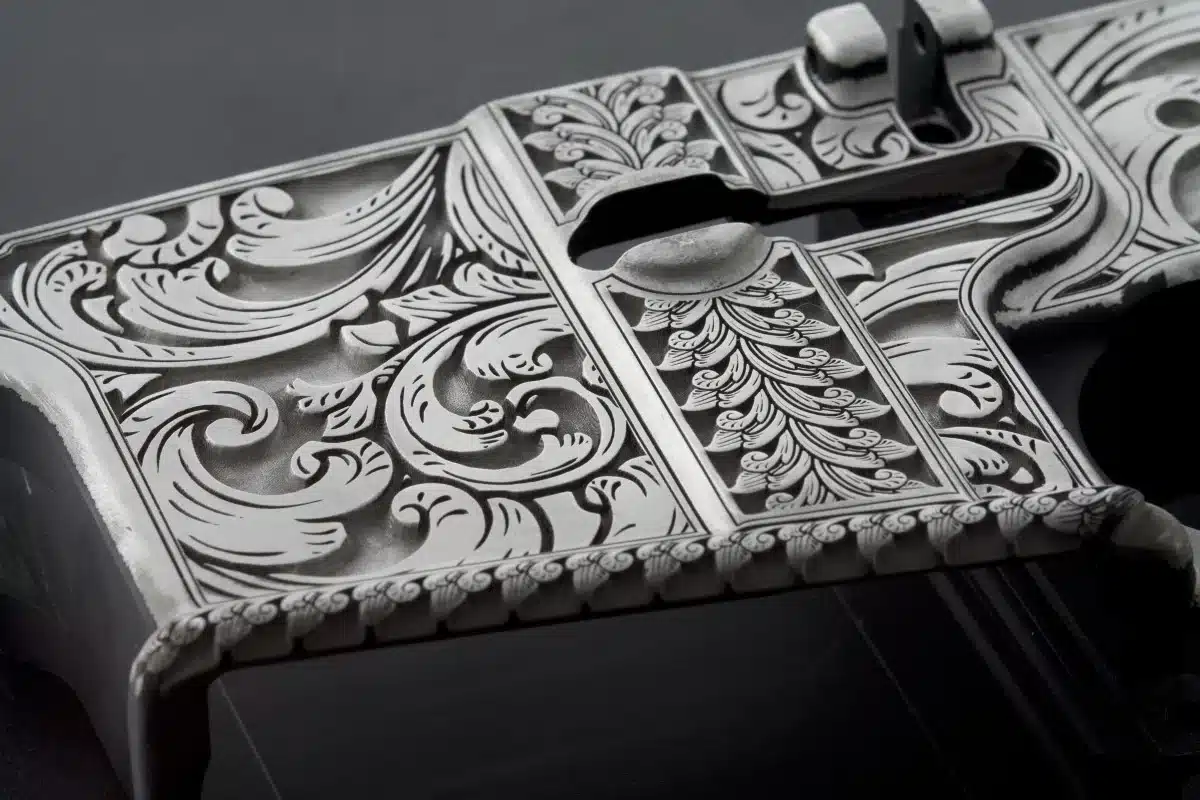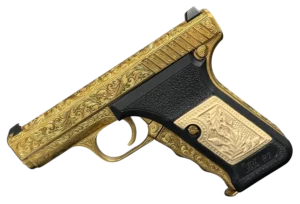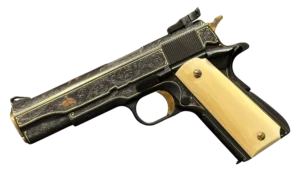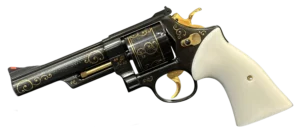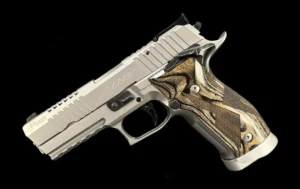Key Takeaways:
- Engraved firearms are more than collectibles — they’re deeply personal works of art, handcrafted by master engravers who pour time, skill, and soul into every scroll and scene.
- FEGA certification stands as the gold standard of American firearms engraving, representing both historical reverence and cutting-edge craftsmanship across generations.
- Each firearm in this article is a living story, combining mechanical precision with cultural significance, and showing that beauty and function can — and do — coexist in the world of fine arms.
Let’s get started
Let’s be honest — most people look at a gun and see a tool. Maybe something for sport, perhaps something for self-defense. But in the right hands, a firearm can become something way more than that. It can be a story told in scrollwork. A memory etched in steel. A piece of history you can hold in your hands.
That’s where the world of engraved firearms — specifically FEGA-certified engraved firearms — comes in. This is where function meets obsession-level craftsmanship. Where gunsmiths hand their work over to artists, and those artists make something that doesn’t just fire — it speaks.
FEGA, short for the Firearms Engravers Guild of America, is the gold standard for this fascinating craft. You don’t just get a FEGA stamp because you know how to etch a few lines. These are people who live and breathe the art — they’ve put in the years, the sweat, the shaky first attempts that eventually lead to masterpieces.
And let’s get one thing clear: engraving isn’t just about making something pretty. It’s storytelling. Commemoration. Identity. Sometimes even rebellion. These guns — the ones we’re about to dive into — aren’t just collectible because they’re rare or expensive. They’re collectible because they’re human. Because someone spent dozens, maybe hundreds of hours, pouring themselves into every curve and line.
So, whether you’re a die-hard collector, a casual admirer, a history buff, or just someone who appreciates beautiful things, this list is for you. Let’s look at ten American-made, FEGA-certified engraved firearms — and the master engravers who made them unforgettable.
Doug Turnbull’s Restored Colt Single Action Army
Where the Old West meets obsessive restoration — and maybe a little bit of poetry.
If you’re into classic American firearms, you already know the Colt Single Action Army — aka the “Peacemaker.” Introduced back in 1873, it’s the six-shooter that rode alongside legends like Wyatt Earp and Billy the Kid. But when Doug Turnbull gets his hands on one? It becomes something entirely different. Not a relic. A resurrection.
Turnbull is more than just a gunsmith. He’s a preservationist with an artist’s eye and a historian’s reverence. His specialty? Bringing vintage guns back to life — but not in a sterile, museum-glass kind of way. He restores them with warmth, like he’s coaxing the soul back into the steel. And when he engraves them, he doesn’t just decorate — he honors.
His version of the Colt SAA is packed with frontier spirit. Intricate scrolls. Wildlife scenes. Flourishes that feel like they were always meant to be there. But somehow, Turnbull makes them feel fresh, like this is what the gun was waiting for all along.
And the best part? He accomplishes everything using traditional methods. No shortcuts. No gimmicks. Just pure, hands-on craftsmanship that respects the era while giving it a little something extra. It’s a paradox in the best way — old and new, untouched and transformed.
In the collector world, a Turnbull-engraved Peacemaker is a unicorn. Whether you’re into Western lore, restoration artistry, or just insanely well-done metalwork, this one ticks all the boxes: high collectibility, timeless appeal, and a whole lot of heart.
Jesse Kaufman’s Winchester Model 21
It’s not just a shotgun — it’s a symphony in scrollwork.
Have you ever seen something so meticulously detailed that it makes you stop mid-sentence? That’s Jesse Kaufman’s take on the Winchester Model 21. It’s the kind of shotgun that doesn’t just sit in a safe. It sits in your memory.
Now, the Model 21 is already a classic in its own right — sturdy, reliable, elegant in that old-school American way. It first appeared in the 1930s and quickly became a favorite among upland hunters and skeet shooters who knew their way around a double-barrel. But once Kaufman steps in with his gravers and imagination? This gun sings.
His engravings are delicate but confident. You get intricate scrolls that dance across the receiver and lifelike game scenes that feel like they’re in motion — birds mid-flight, deer mid-leap. You can almost hear the crunch of leaves underfoot or the wings breaking the sky. That’s the level of storytelling going on here.
What’s cool about Kaufman is that he doesn’t just embellish for the sake of it. Every element ties back to the shotgun’s purpose — the wild, the tradition, the chase. It’s a love letter to the outdoors and the people who live for it.
In terms of collectibility, a Kaufman-engraved Model 21 sits in that perfect sweet spot — revered base gun, top-tier engraver, and art that feels alive. If you get your hands on one, good luck letting it go.
Lee Griffiths’ Browning Superposed
Old World charm. New World flair. All done with the tip of a graver.
There’s something undeniably romantic about an over-under shotgun. Especially one like the Browning Superposed — the last gun John Browning ever designed. And when Lee Griffiths gets hold of one? It turns into a visual love letter to both American and European gunmaking traditions.
Griffiths is one of those engravers who seems to operate in two worlds at once. He’s deeply rooted in classic techniques, but he’s not afraid to incorporate bold, modern flourishes as well. And that’s precisely what he does with the Superposed — blending tight European-style patterns with broader, almost cinematic American wildlife scenes.
The result? A shotgun that feels like it should be hanging in a gallery one minute… and breaking clays the next.
Griffiths doesn’t just carve — he composes. You’ll find sprawling landscapes, majestic animals, and ornamental scrollwork that pulls it all together like a frame around a masterpiece. But even with all that detail, the gun never feels overwhelmed. Everything is balanced. Purposeful. Quietly grand.
If you’re the kind of person who gets chills from the meeting of craftsmanship and culture, a Griffiths-engraved Superposed is going to hit you right in the feels. Collectors know it too. These don’t just turn heads — they turn conversations.
Brian Powley’s Smith & Wesson Model 29
“Do you feel lucky?” Actually, yeah — if you’re holding this.
Let’s get this out of the way: the Smith & Wesson Model 29 is already an icon. Thanks to Clint Eastwood and Dirty Harry, it holds the title of “most famous revolver in American cinema.” But Brian Powley? He doesn’t ride coattails. He adds a whole new chapter.
Powley is what you’d call a perfectionist — but not in a stiff, sterile way. His engravings are wildly intricate, sometimes dizzyingly so, yet they always feel organic. He works in layers, building depth and rhythm like a musical composition you can see instead of hear.
On the Model 29, that means scrollwork that flows with the curves of the frame like water. Gold inlays that accent without shouting. Maybe even a nod to the gun’s Hollywood roots — a little flair, a little swagger.
And while the Model 29 is no stranger to the spotlight, Powley gives it gravitas. You stop seeing it as a “movie gun” and start seeing it as something sacred. Something that tells a story bigger than any script.
Collectors? They’re all over it. A Powley-engraved .44 Magnum isn’t just a firearm — it’s a cultural artifact. It’s muscle and magic wrapped in blued steel. It’s “Dirty Harry,” yes, but it’s also delicate. That contrast? That’s where the magic is.
Ben Lane’s Marlin 1895
The West wasn’t tamed. It was engraved.
The Marlin 1895 has that wild, dust-blown, saddle-scabbard energy baked into its bones. It’s not a polite rifle. It’s bold. American to its core. So when Ben Lane lays his tools on it, the result isn’t just engraving — it’s frontier mythology made permanent.
Lane has this uncanny ability to evoke mood through metal. His engravings feel like sepia-toned photographs come to life. You get bison herds thundering across the plains. Cowboys mid-standoff. Vultures circling under sun-bleached skies. Okay, maybe not all that on one gun — but you get the idea.
It’s storytelling with teeth.
He respects the lines of the Marlin 1895 — lets the gun’s muscular shape lead the way — but he adds layers of soul. His scrolls aren’t just decoration. They’re echoes—hints of where the rifle might have been… or who might have carried it.
As for collectibility? Lane’s work on the 1895 lands is somewhere between high desire and can’t let it go, especially for those drawn to Americana and the mythos of the West. This is the kind of rifle you hang on the wall — not just for show, but because it means something.
Sam Welch’s Ruger No.1
One shot. One chance. One incredible canvas.
The Ruger No.1 is a bit of a loner in the world of rifles. A single-shot beauty that makes you slow down, breathe, and shoot with purpose. There’s something poetic about that — and Sam Welch gets it, which is probably why his engravings on this platform feel so… grounded.
Welch is known for detail, not just in line work, but in tone. His scrolls whisper instead of shouting. His wildlife scenes are more observation than exaggeration. A deer looking back over its shoulder. A hawk mid-hover. Little moments that feel real because they are.
With the No.1, Welch doesn’t overwhelm. He compliments. The action stays smooth, the lines remain clean, and the elegance gets turned up to eleven.
Collectors sometimes overlook the Ruger No.1 — it doesn’t have the lever-action flash or semi-auto swagger. But when does Welch put his stamp on it? It’s elevated. Personal. Quietly magnificent.
C.J. Cai’s Colt Python
It was already a legend — now it’s a legend with lacework.
There’s something about the Colt Python that already feels too good to be real—silky-smooth action. Perfect balance. That sinuous, almost smug silhouette. It’s like the revolver world’s answer to a tailored Italian suit — sleek, refined, iconic.
And then C.J. Cai steps in… and somehow makes it better.
Cai’s engraving doesn’t just decorate the Python. It dances with it. The scrollwork flows like liquid mercury — smooth, confident, almost hypnotic. And it’s not just about looking good (though it does). It’s about matching energy. The design’s grace mirrors the gun’s mechanical precision in a truly satisfying, almost poetic way.
You can tell Cai’s not just following a pattern. He’s reacting to the curves, the weight, the legacy. Every line is intentional, every flourish earned.
Collectors? They’re head over heels. The Colt Python already has die-hard fans. Add Cai’s craftsmanship to the mix, and you’ve got something that doesn’t just deserve a spot in a display case — it deserves a spotlight. Or maybe a museum wing.
If the original Python was the Ferrari of revolvers, Cai’s version is the one with the hand-stitched interior and gold-leaf trim — somehow flashier and classier at the same time.
Mark Hoechst’s Remington 700
Precision meets panorama — this rifle doesn’t whisper; it tells stories.
Let’s get one thing straight: the Remington 700 is kind of the Honda Civic of bolt-action rifles — insanely popular, freakishly reliable, and almost endlessly customizable. But when Mark Hoechst lays his engraver’s tools on it? That Civic becomes a hand-painted Land Rover crawling across the savannah.
Hoechst’s style leans into storytelling, especially when it comes to wildlife. Think moose framed by autumn trees, a grizzly mid-roar, or pheasants just lifting off the ground — scenes that practically rustle with movement.
His work on the 700 feels like an ode to the outdoors. And not just in a “wow, pretty forest” way. In a way that says: I’ve been there. I know what that chill in the morning air feels like when you’re watching the treeline. That’s intimate.
He’s also a master of restraint. The engravings enhance the gun’s sleek silhouette rather than fighting it. He lets the lines breathe, enables the detail to settle in quietly, and in doing so, creates a kind of reverent, wilderness poetry.
Now, is a Hoechst-engraved Remington 700 going to appeal to the tactical crowd? Maybe not. But for the hunter who sees beauty in the chase and nostalgia in every cartridge? It’s just about perfect.
John Barraclough’s Beretta SO6 EELL
When Italian elegance meets American steel, everybody wins.
The Beretta SO6 EELL is one of those shotguns that already screams “bespoke.” Handmade by one of the oldest gunmakers in the world, this thing is the Rolls-Royce of sporting shotguns — even before the engraving.
But in John Barraclough’s hands, it becomes something else entirely. Not just refined. Not just elite. Personal.
Barraclough approaches engraving like a cultural handshake. His work on the SO6 doesn’t try to outshine the Italian craftsmanship — it complements it. He brings in classic American motifs, subtle nods to nature, and scrollwork with an almost architectural elegance. The result is a seamless blend of two traditions, like a duet between opera and bluegrass that somehow just… works.
It’s the kind of shotgun that doesn’t feel locked in time. Instead, it feels timeless—a meeting place between past and present, East and West—one foot in Gardone Val Trompia, the other in Montana.
Collectors notice that. A Barraclough-engraved SO6 isn’t just valuable — it’s interesting. It’s got layers. It’s got a backstory. It’s got soul.
Martin Butler’s Kimber 1911
Old soul, modern edge — this one’s got something to say.
Alright, last but never least: the Kimber 1911. You already know the M1911 is a legend — born in war, reborn in competition, and still standing tall over a century later. Kimber gave it a modern reboot. Then Martin Butler came along and gave it a whole new language.
Butler doesn’t just follow rules — he flirts with them. His engraving on the Kimber 1911 blends old-school scrolls with modern geometry, layering tradition with just the right amount of edge. Think Art Nouveau meets cyberpunk. Okay, maybe not that extreme — but it’s got a tension to it, a pulse.
His designs lean into the contrasts of the gun itself: a classic silhouette meets modern mechanics. And the engraving echoes that — graceful curves meeting sharp angles, soft flourishes rubbing elbows with bold lines.
What makes Butler’s work sing is its energy. It feels intentional but not overworked. Emotional but not showy. Like someone who respects history but isn’t afraid to remix it.
And that makes it perfect for modern collectors, especially those who want a piece that speaks to the past while still looking fresh in a contemporary setting. A Butler-engraved Kimber 1911 isn’t just a nod to what was. It’s a wink at what’s next.
The Craft Behind the Canvas: Engraving Styles & Techniques
How do you turn cold steel into something that feels alive? With patience. And probably a good magnifier.
Engraving a firearm isn’t just about making it look nice. It’s about transformation — taking something functional and giving it a soul. And depending on the engraver’s tools (and mood), that soul might come out as a whisper of scrolls or a full-blown wildlife diorama wrapped around the receiver.
There’s hand engraving, which is precisely what it sounds like — no machines, just a graver, a steady hand, and a whole lot of muscle memory. It’s slow, unforgiving work, but the results are unmatched. You can feel the humanity in every curve.
Then there’s bullino engraving, which takes handwork to obsessive levels. Picture tiny dots and lines packed so densely they start looking like a pencil sketch or a black-and-white photo. It’s delicate. It’s demanding. And it’s drop-dead gorgeous when done right.
Inlays? That’s when gold or silver gets worked into the steel. It’s flashier, sure, but not in a cheap way. Think more Fabergé than fireworks. When done correctly, inlays appear as if the metal is growing out of itself.
We also have acid etching, which sounds like a science class but involves masking off parts of the steel and letting acid carve the rest. Not quite as romantic, maybe, but it gets the job done, especially for repeating patterns or background textures.
And, yes, machine and laser engraving are now part of the picture. Some folks turn up their nose at the idea of a computer doing the work, but let’s be real: the precision is incredible. Plus, when artists use lasers to lay a base and then come back in by hand? Chef’s kiss.
The style itself depends on the artist and the story they want to tell. You’ve got:
- Scrollwork, classic and swirling like vines on a cathedral wall.
- Relief engraving, where patterns emerge like sculptures.
- Floral motifs for that organic, European grace.
- Animal scenes that breathe life into the steel, especially on hunting rifles.
Each style has its place. Some shout, some whisper. But all of them — when done right — turn a gun into a personal expression. A canvas you can cock, load, and fire.
Meet the Makers: The Engravers Behind the Masterpieces
They don’t just engrave metal — they engrave memory.
The artists behind these firearms aren’t just technicians. They’re storytellers. They know how to speak in metal and light, how to use a tiny blade to carve meaning into something you can hold.
Doug Turnbull doesn’t just restore the Colt SAA — he resurrects it. With every engraved detail, he captures the romance of the frontier, reminding you that the past still has stories to tell.
Jesse Kaufman breathes life into the Winchester Model 21, turning a sporting tool into a living snapshot of American wilderness. His scrolls and game scenes feel like a memory, familiar, even if you’ve never been there.
Lee Griffiths does this strange, beautiful thing where he channels the refinement of Europe and fuses it with raw American heart. His Browning Superposed is what happens when two cultures fall in love on the same piece of steel.
Brian Powley? The guy could probably engrave a toaster and make you cry. His Model 29s carry cinematic weight, yes — but also the emotional gravity of something made to last.
Ben Lane takes the Marlin 1895 and turns it into a dusty, golden-age novel you can shoulder. His work is authentic, like he’s been in those frontier scenes he’s carving.
Sam Welch, with the Ruger No.1, keeps things understated, with quiet confidence. His detail is precise, his execution flawless. He’s a master of restraint, which makes the work hit even harder.
C.J. Cai transforms Python into something you don’t just admire — you study. His work is smooth, elegant, and intuitive, like the revolver was always meant to wear this engraving.
Mark Hoechst puts the wild into the Remington 700. His game scenes feel like windows into real places — raw and reverent.
John Barraclough finds harmony between two worlds with the Beretta SO6. It’s part Italian opera, part American folk song — and it works beautifully.
And Martin Butler? His Kimber 1911 engravings are what you’d get if you asked tradition and modernity to dance. He bridges eras, ideas, and tastes — and he does it with style.
These engravers aren’t just marking up metal. They’re marking time, memory, and emotion. Their work doesn’t just shine — it lingers.
Why People Collect These — And Why It’s More Than Just Showing Off
It’s not about the flex. It’s about the feeling.
Sure, some people collect engraved firearms because they’re rare. Or valuable. Or a good investment. But talk to a serious collector, and you’ll find out it’s way more personal than that.
Every FEGA-certified piece is one-of-a-kind. Not “limited edition.” Not “custom.” One. Of. One. You’re holding something someone spent weeks obsessing over, crafting by hand, chasing perfection one groove at a time.
There’s history in there — both in the design and the execution. Some collectors are drawn to the Old West spirit, or the WWII grit, or the nostalgia of upland hunting. Others are drawn to the art itself — the balance, the creativity, the shock of seeing a tool become something beautiful.
And let’s not ignore the actual investment angle. These pieces tend to appreciate, not just because they’re rare, but because they’re respected. FEGA certification means something. It tells buyers, sellers, and fellow collectors: this was done right.
But really, it all comes back to the story. The stories these pieces tell — and the stories their owners tell because of them. That’s why they get passed down. That’s why they end up behind glass, or over fireplaces, or in safes lined with velvet.
They aren’t just guns. They’re heirlooms. Artifacts. Legacy, in steel and scroll.
The Craft Lives On: Why Engraving Still Matters
The future’s got lasers, sure. But it also has heart.
Some people assume this kind of engraving — the hand-done, time-intensive kind — is dying out. And to be fair, it’s not the easiest career path. You don’t stumble into this. You chase it.
But here’s the thing: engraving is very much alive. And it’s growing, in its way. FEGA continues to train, mentor, and advance this craft. Old-timers teach newcomers. Workshops are packed. Tools are still handed down like secret family recipes.
Young engravers are emerging with fresh ideas — bringing new styles, new influences, and even blending old-world methods with technology. It’s not tradition or innovation. It’s both. Engraving is evolving, but it hasn’t forgotten its roots.
And that matters. Because every time someone picks up a gun and leans over a barrel, they’re doing more than decorating a weapon. They’re carrying a tradition forward. They’re saying: this still matters.
In a world that moves faster every day, engraving asks us to slow down. To notice. To appreciate the lines, the labor, the story behind every swirl. That’s why it endures.
Final Thoughts: Steel, Soul, and the Art That Lives Between
Because sometimes, the prettiest thing in the room is also the deadliest. And that’s the point.
FEGA-certified engraved firearms don’t just live at the intersection of form and function — they own it. They prove that a gun can be more than a tool. It can be a tribute. A memory. A conversation starter. A work of art that just so happens to fire a bullet.
Whether you’re a collector, a shooter, an artist, or just someone who appreciates detail done right, these pieces speak. They speak of time, patience, obsession, and love. They whisper of the past and hint at the future.
And above all? They remind us that beauty doesn’t have to be soft. Sometimes, it can be hard steel, lovingly carved by a pair of aching hands. Sometimes, it can be loud.
Frequently Asked Questions
FEGA (Firearms Engravers Guild of America) certification is a prestigious recognition awarded to master engravers for their exceptional craftsmanship and artistry in firearms engraving.
FEGA-certified firearms feature intricate, hand-engraved designs created by highly skilled artisans. Each piece is a testament to artistry, blending functionality with aesthetics, making them sought-after collectibles.
Engraved firearms, particularly those certified by FEGA, are valued higher due to the artistry, labor, and unique designs involved. Their rarity and craftsmanship often make them prized assets for collectors.
Techniques like relief engraving, gold inlay, and shading are popular, often executed on high-grade steel and accented with precious metals like gold and silver.
FEGA fosters the art of engraving through education, standards, and recognition of skilled artisans, ensuring the tradition continues to thrive.


